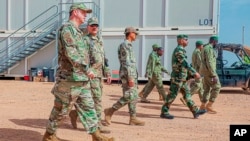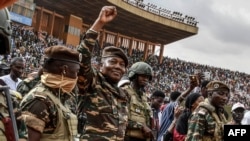The U.S. abandonment this week of its $110 million drone base in Niger, once seen as a key hub for counterterrorism efforts, adds to a growing list of Western withdrawals, all steadily ceding ground to terror groups affiliated with Islamic State and al-Qaida.
Officials with U.S. Africa Command announced the final departure of troops from Air Base 201 in Agadez on Monday, completing a process that began last year when a military junta overthrew Niger’s democratically elected president and demanded U.S. forces leave.
The U.S. withdrawal follows the pullout of French forces from Niger late last year and from neighboring Mali in 2022. A five-country alliance to fight terror groups across the Sahel, likewise, collapsed in recent years.
And intelligence gathered by United Nations member states suggests the terror groups those Western forces were hoping to curtail have made the most of their growing absence.
The al-Qaida-linked Jama’a Nusrat ul-Islam wa al-Muslimin, also known as JNIM, has become “the most significant threat in the Sahel,” according to a U.N. Sanctions Monitoring Team report released last week.
JNIM commands 5,000 to 6,000 fighters, the report said, and “continues to expand, mostly in Burkina Faso, but also significantly in Mali and the Niger."
And while the intelligence suggests JNIM has not given up on striking Western interests in the Sahel, the group’s ability to expand and consolidate territorial gains could put it in position "to establish an emirate from central Mali to northern Benin,” the report warned.
The Islamic State terror group’s affiliates in the region have also made gains.
The U.N. report warns that IS’s West African Province, also known as ISWAP, “has grown in both importance and capability," working with IS core leadership to establish terror cells and networks in Nigeria and beyond.
Estimates from U.N. member states put the number of ISWAP fighters at between 4,000 and 7,000. But much of their focus has been on supporting Islamic State in the Greater Sahara, or ISGS, with 2,000 to 3,000 fighters seeking to expand beyond their entrenched positions in Mali and the border regions of Burkina Faso and Niger.
Making matters more precarious, the U.N. report warned that a tenuous détente (an unofficial agreement) between the al-Qaida-affiliated JNIM and ISGS appears to be holding, “with the continued trend of the groups taking and holding larger areas of contiguous territory in the Sahel."
Some analysts who study the region caution that the trendlines are unlikely to change.
“What we're witnessing right now is the direct consequence of all the coups in the region and the fact that all these troops have been driven out — the French, Belgians, MINUSMA [United Nations Multidimensional Integrated Stabilization Mission in Mali], African Union, the Americans,” said Pieter Van Ostaeyen, a Belgian Arabist who studies Islamic extremism.
“It's like a carousel won't stop,” he told VOA. “It's like a downward spiral.”
Van Ostaeyen said that is reflected in the number of attacks claimed or attributed to JNIM and the IS affiliates.
According to his data, the groups averaged 125 attacks per month over the first five months of this year, compared to just over 50 attacks per month during the same period a year ago.
And Van Ostaeyen sees no indications that any of the region’s militaries have what it takes to stop the spread of violence.
“Right now, it's like the Islamic State and JNIM are partly dividing Mali and Burkina Faso. Niger will fall completely to the jihadis, as well,” he said.
Liam Karr, the Africa team lead with the Washington-based Critical Threats Project at the American Enterprise Institute, also sees little reason for hope.
“In many cases, due to the illicit networks that a lot of these terror groups sit on, they might be more wealthy than a lot of the actual countries that they're operating against,” Karr told VOA.
There are also massive concerns about the role Russian official forces and paramilitary forces, like the Wagner Group or the recently formed Africa Corps, are playing in countries like Mali and Niger as Moscow seeks to gain influence.
"We see that Wagner has been very, very progressive at trying to establish control in African countries," said U.S. Africa Command’s General Michael Langley, briefing reporters this past June.
“This does not enhance security or stability,” he said.
Additionally, there are also concerns about the capacities of the Russian forces in Africa. Western officials have long warned the main goal of groups like Wagner has been to help Russia secure access to natural resources.
And some recent events, like an attack by separatists in northern Mali that is said to have killed more than 80 Wagner mercenaries, have cast further doubts on Russian competence.
Analysts like Karr also argue that even if Russia wanted to help push back against terror groups, the numbers are lacking.
“The Russian footprint there is much smaller,” Karr said. “Especially in somewhere like Niger, from a quantity standpoint, you have roughly 100, maybe, to 200 Russian forces taking the place of what was 1,500 French troops and over 1,000 U.S. service members.”












